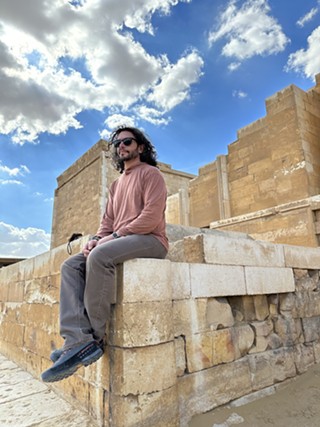"Everybody has a secret world inside of them. I mean everybody. All of the people in the whole world, I mean everybody—no matter how dull and boring they are on the outside. Inside them they've all got unimaginable, magnificent, wonderful, stupid, amazing worlds. Not just one world. Hundreds of them. Thousands, maybe."
—Neil Gaiman
Esteemed Reader of Our Magazine:
I really love Neil Gaiman. I mean I love his writing, but I feel like I know him, his inner life, through his writing. I savor the deep, sensual enjoyment he evidently takes in crafting prose, his ability to resist resorting to gratuitous negativity, and the almost esoteric, mythical narratives he creates. Mostly I love that Gaiman conveys a profound sense of an invisible, omnipresent separate reality. He gives the sense that reality is comprised of coexisting and interacting strata of worlds.
Gaiman is not the only contemporary author that does this well (though he may be the only one that's local!). I count Phillip Pullman, Hayao Miyazaki, Lewis Carroll, C. S. Lewis, and some others in the same category of contemporary world-weaving mythologists. The effect is to be drawn into a greater consciousness.
Most comparable writing is ancient and its authors are anonymous, including the mythology and scripture of every tradition. These are the tales that interweave the visible and invisible worlds; the myths in which the natural, supernatural, and supra-natural are simultaneous and overlapping; the stories that describe a reality in which gods, spirits, and men walk together and time transcends the linear model.
The idea of these interpenetrating worlds has rung true in the psyche of humanity for all recorded history. It's in Norse cosmology, which shows nine worlds strung on the world tree, Yggdrasil. It's in the Indian Vedas, Sumerian epics, Egyptian creation stories, and the Old and New Testaments.
This cosmology is even reflected in the western musical scale of hermetic origin, describing seven worlds within one body like an ever-growing cosmic tree whose branches grow in every direction, in descending octaves from universe (DOminus), to starry world (SIderea), to our Milky Way (LActe), to our sun (SOL), to the fated movements of the planets (FAta), to the Earth (MIcrocosmos), to our moon—the queen of the sky (REgina). Each describes a world of progressively greater magnitude, refinement, and freedom.
I think this fascination with simultaneous and interacting worlds rings true because it is true. We can look to our own experience to inquire into and perhaps verify the concept.
Firstly, we live in a world of material objects, in which things interact in a linear flow of time. Our own bodies exist in this world, and most of our lives have to do with caring for these bodies and with obtaining other objects, substances, and interactions that support the well-being and enjoyment of our bodies. Indeed the entire cosmology embodied in the worldview of science and medicine takes the world of physical bodies to be the "real" world. This idea is so ingrained and dogmatic that to suggest otherwise is a kind of heresy. But there is another world that, from an experiential standpoint, may possess an even greater reality.
We experience this second world as our inner life and describe it in the language of qualities—art, poetry, scripture, and narratives that relate the qualitative experience arising between things. The media of the second world is the stuff of the psyche—thought, feeling and emotion, sensation, and consciousness. This world is usually invisible because, like water to fishes, it is the medium in which we swim. But this inner life-stuff is actually the way we know and metabolize the experience of everything in the object world. It may even be its template and origin.
The science of objects would have us believe that our inner life is a byproduct of physiological processes, but this assumption begs a healthy skepticism and inquiry. It may be that the inner-life-stuff permeates everything living and non-living, that all apparent objects and their relationships are imbued with a qualitative existence and consciousness. Perhaps this second world in fact provides the substrate and matrix of the material world. Most importantly, we may experience this by inhabiting the media of our own psyche, and experiencing the objects of things and people with a view to their inner content.
There's at least a third world that the shamans of ancient Mexico, via Carlos Castaneda, called Intent. Intent is the action of creative will, intention, which by virtue of arising from a larger, more encompassing world, can imbue the qualitative realm of inner life-stuff with a coherent pattern and intelligence. A simple example is anything constructed, like a stone wall, in which we can see preserved and reflected the action of the builder's intention, projected through her skill, creativity, and capacity.
As Gaiman suggests, we are made to experience and dwell in these interpenetrating worlds. It is the birthright of born humans and the destiny of evolved humanity to live in at least three worlds. Though we live in a few small rooms, the whole house is ours to inhabit.













